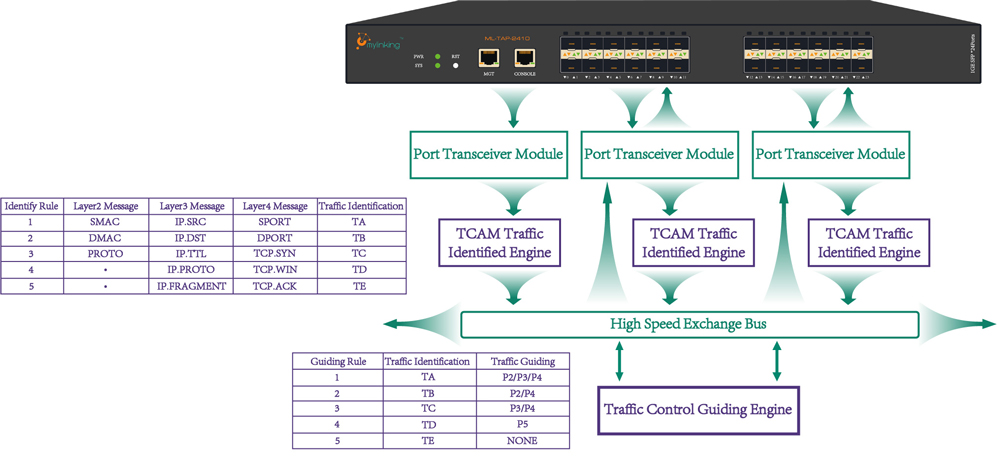1- Overviews
- A full visual control of Data Acquisition device(24*GE SFP slots)
- A full Data Scheduling Management device(duplex Rx/Tx processing)
- A full pre-processing and re-distribution device(bidirectional bandwidth 24Gbps)
- Supported collection & reception of link data from different network element locations
- Supported collection & reception of link data from different switch routing nodes
- Supported raw packet collected, identified, analyzed, statistically summarized and marked
- Supported to realize irrelevant upper packaging of Ethernet traffic forwarding, supported all kinds of Ethernet packaging protocols, and aslo 802.1q/q-in-q, IPX/SPX, MPLS, PPPO, ISL, GRE, PPTP etc. protocol packaging
- Supported raw packet output for monitoring equipment of BigData Analysis, Protocol Analysis, Signaling Analysis, Security Analysis, Risk Management and other required traffic.

ML-TAP-2401
2- System Block Diagram

3- Operating Principle

4- Intelligent Traffic Processing Abilities
6- Specifications
| Mylinking™ Network Tap NPB/TAP Functional Parameters | ||
| Network Interface | GE ports | 24*GE SFP slots |
| 10GE ports | - | |
| Deployment mode | SPAN monitoring input | support |
| In-line mode | support | |
| Total QTYs interface | 24 | |
| Traffic replication / aggregation / distribution | support | |
| Link QTYs supporting Mirror replication / aggregation | 1 -> N link traffic replication (N <24) N-> 1 link traffic aggregation (N <24) G Group(M-> N Link) traffic replication and aggregation [G * (M + N) <24] | |
| Functions | Distribution based on traffic identification | support |
| Distribution based on IP / protocol / port Five tuple traffic identification | support | |
| Distribution strategy based on protocol header the key labeled traffic identifies | support | |
| Strategic distribution based on deep message content identification | support | |
| Support Ethernet encapsulation independence | support | |
| CONSOLE Network Management | support | |
| IP/WEB Network Management | support | |
| SNMP V1/V2C Network Management | support | |
| TELNET/SSH Network Management | support | |
| SYSLOG Protocol | support | |
| User authentication function | Password authentication based on user name | |
| Electric(1+1 Redundant Power System-RPS) | Rated supply voltage | AC110-240V/DC-48V [Optional] |
| Rated power frequency | AC-50HZ | |
| Rated input current | AC-3A / DC-10A | |
| Rated power function | 150W(2401: 100W ) | |
| Environment | Operating Temperature | 0-50℃ |
| Storage Temperature | -20-70℃ | |
| Operating Humidity | 10%-95%, Non-condensing | |
| User Configuration | Console Configuration | RS232 Interface, 9600,8,N,1 |
| Password authentication | support | |
| Rack Height | Rack space (U) | 1U 460mm*45mm*440mm |
7- Order Information
ML-TAP-2401 mylinking™ Network Tap 24*GE SFP ports
ML-TAP-1410 mylinking™ Network Tap 12*GE SFP ports plus 2*10GE SFP+ ports
ML-TAP-2610 mylinking™ Network Tap 24*GE SFP ports plus 2*10GE SFP+ ports
ML-TAP-2810 mylinking™ Network Tap 24*GE SFP ports plus 4*10GE SFP+ ports
FYR: Comparison of different types of interfaces for adding or stripping VLAN tags
| HOW EACH TYPE OF INTERFACE HANDLES DATA FRAMES? | |||
|---|---|---|---|
| Interface Type | Rx Message without Tag Process | Rx Message with Tag Process | Tx Frame Process |
| Access Interface | Receive the message and type the default VLAN ID | • Receive the message when the VLAN ID is the same as the default VLAN ID. • discard the text when the VLAN ID is different from the default VLAN ID. | First strip the PVID Tag of the frame and then send it. |
| Trunk Interface | • type the default VLAN ID and receive the message when the default VLAN ID is in the list of VLAN ids that are allowed to pass. • type the default VLAN ID and discard the text when the default VLAN ID is not in the list of VLAN ids that are allowed to pass. | • receive the text when the VLAN ID is in the list of VLAN ids that the interface allows to pass. • discard the text when the VLAN ID is not in the list of VLAN ids that the interface allows to pass through. | • when the VLAN ID is the same as the default VLAN ID and is the VLAN ID allowed by the interface, remove the Tag and send the message. • when the VLAN ID is different from the default VLAN ID and is the VLAN ID allowed by the interface, keep the original Tag and send the message. |
| Hybrid Interface | • type the default VLAN ID and receive the message when the default VLAN ID is in the list of VLAN ids that are allowed to pass. • type the default VLAN ID and discard the text when the default VLAN ID is not in the list of VLAN ids that are allowed to pass. | • receive the text when the VLAN ID is in the list of VLAN ids that the interface allows to pass. • discard the text when the VLAN ID is not in the list of VLAN ids that the interface allows to pass through. | The message is sent when the VLAN ID is the VLAN ID that the interface allows to pass through. You can use commands to set whether to send with a Tag or not. |